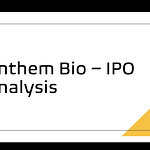Side note: all comments and questions can be added here (central location helps track and trace for faster turnaround):
Q1 F26 Results Roster and Q&A
It’s a proud moment for Glenmark Pharma and their scientists. I’ve heard many companies “talk” about out-licensing novel assets from Wockhardt to Biocon, but Glenmark used to do this in 2005, and the…
Random Question Time (RQT) is a new series with an irregular schedule, depending on my availability. Anyone can ask questions, and if a question is particularly interesting or valuable, I’ll gladly dedicate a special response post to it.
Here are the random questions that made it into the inaugural report:
Key takeaways for anyone aiming to maximise their return on time invested (ROTI).
By product complexity, I meant the “value add” shown through gross margins. All else equal, a company with higher gross margins will generate greater sales and asset turnover using the same raw material input and CAPEX.
Two companies in the same field can have entirely unique structures, strategies (e.g., China plus 1 and/or EU plus 1), resources, competencies, and competitive positioning, to name a few. As a result, it is critical to exercise caution when comparing “short term” ratios or reaching definite conclusions based exclusively on shorter timeframe quantitative indicators.
The scale and nature of backward or vertical integration, as well as the distinction between what is sold in the market and what is consumed internally, need to be understood.
There are advantages and disadvantages to both asset-light (low backward integration) and asset-heavy (backward integrated), and there is no universal answer that works for all scenarios.
Laurus Labs Gross Block period ending in F22 was 3,755, and F25 sales were 5,554, generating an (S+3)/GB ratio of 1.48. In comparison, Divis Labs gross block period ending in F22 was 5,624, and F25 sales were 9,360, generating an (S+3)/GB ratio of 1.66 and Neuland’s 1.58 for F25 sales over F22 GB. Interestingly, this ratio was 1.84 (F24 sales over F21 GB).
NB: Laurus and Divis differ in many ways, but they are more similar to each other than Laurus is to Neuland (which is the focus of the question).
Second part of the question (why Pharma asset-turns are lower than a generic speciality chemicals company)
Lower asset turns than speciality chemicals is due to lower output per unit of gross block (strict particle size, impurity compliance, and sterility regulations, which increases rejection rates)
In addition, strict expiry regulations increase inventory write-offs (sales recall)
Pharma gross margins are generally better than chemicals, but OPEX is also higher
Extensive regulatory compliance & documentation (OPEX)
Data protection, filings, post-marketing surveillance, and increased quality and safety measures raise operating costs (OPEX)
Management of intellectual property and sales/medical teams adds costs (OPEX)
API companies typically have higher fixed costs than chemical KSM and intermediates
The questions from Shishir Bhat and Neel Soni deserves a deeper, more detailed response.
Let’s take a simple, hypothetical example and assume all CAPEX and sales are in INR crores.
Now assume that Company “BI” is backward-integrated and Company “NBI” is not backward-integrated. There are primarily four reasons any company will opt for complete BI—a) supply security, b) cost/economics, c) purity, and d) overall control and confidence in the sustainable, timely, and repeatable (STR) execution. Of course, there maybe other reasons companies prefer integration, but for the purpose of this RQT response, we can take these as the top four reasons.
One or more of the above reasons will encourage the decision to go for backward integration. Now let’s assume that the current theme for global big-pharma is to "de-risk my supply chain" and make it independent or less dependent on China or any single country for that matter.
If the KSM and intermediates are supplied by companies located outside China but within a single jurisdiction, and that jurisdiction is on the approved and preferred list, the innovator will be comfortable with this setup. Let’s assume that this jurisdiction is India, where both KSM and intermediates are produced by Indian chemical companies, and the API manufacturer is also based in India. These players can then work together with the innovator to coordinate logistics and move the final product through production. However, this arrangement might increase the workload for big-pharma companies, as they will need to manage multiple relationships, resulting in higher administrative overhead. Often, the API partner takes care of the “backend”.
From an innovator’s administrative and relationship management perspective, a single player that can handle all the complexity at scale meets the required qualification standards. Most Indian API companies have limited backward integration at the KSM level. Some manufacture intermediates in-house, but even these companies often rely on a vendor network for certain ingredients. This reliance is common and considered acceptable.
Besides the four factors mentioned earlier (cost, quality, supply security, and STR), there are also chemistry and intellectual property challenges that often drive companies like Laurus to fully own and control the entire value chain for certain products. This is especially true when the synthesis process involves the latest set of technologies with limited competition: enzymes, biocatalysis, and continuous flow reactions at scale.
Making a small molecule with a complex, multi-step synthesis in large volumes requires extensive, parallel processing to meet deadlines. However, this setup can lead to significant underutilisation and downtime during clinical phases or process validation. While the CAPEX and infrastructure costs are tangible, these periods of low activity greatly increase operating inefficiencies, which ultimately weigh on EBITDA margins. We saw early signs of this with Laurus in fiscal 2024 and through most quarters of fiscal 2025.
In this scenario, although capital expenditures are spread across the entire value chain, sales are generated only from the final API or intermediate—not from the individual building blocks that feed into the finished product. As a result, the asset turnover based on the gross block will appear lower than it actually is. However, backward integration still provides the CDMO player with the necessary license to compete in RFQs and the advantage needed to win contracts. For several RPQs, big-pharma demands scale and capability combination across the value chain, and not just the final product.
Source: author’s own analysis
Now imagine managing multiple such setups simultaneously to handle a pipeline of 70 to 80 projects at any given time. The gross block will appear enormous on paper, but output might seem low if many projects are still in phase 1 or phase 2. As molecules advance into late phase 3 and commercialisation, the flexible infrastructure will be put to better use, resulting in improved asset turnover, a significant reduction in negative leverage, and eventually stronger operating leverage.
Advantages of vertical or backward integration
1. You get way better control over your supply chain, so things like timing and quality are easier to manage.
2. It can save you money by cutting out middlemen and keeping the profit inside your company.
3. You’re less dependent on outside suppliers, which means fewer chances of running into disruptions beyond your control.
4. Keeping production in-house helps protect your secret sauce—your tech, processes, or trade secrets stay safe.
5. It’s easier to customise products and try new ideas when the different stages of making stuff are working closely together.
6. Owning key resources can make it tough for competitors to break into your market.
Drawbacks of vertical or backward integration
1. Setting up or buying facilities and bringing everything in-house takes a lot of upfront cash and can be pretty risky and draining.
2. Compared to outsourcing, it may make it harder to quickly pivot with market changes, new trends, or swap out suppliers.
3. It takes a long time before you start seeing benefits, so it’s not ideal for businesses that want quick wins or need to pivot fast.
4. Managing lots of different operations means more complexity, and you need a wide range of skills and management bandwidth to pull it off.
5. You might lose focus because spreading your resources over too many areas can mess with your core strengths.
Now let’s look at the second part of Shishir Bhat’s question.
“
I had a question from your book pg.172 where you mention
"Asset turns are a function of product complexity, backward integration (full backward integration yields lower asset turns compared to partial backward integration), and sector (chemicals will yield much better asset turns compared to pharma in the same gross block)"
It would be really helpful if you could please elaborate on the point wrt backward integration and sector?
”
Compared to a regular chemical operation, running a pharma company entails a significant increase in complexity and costs. Running a pharma company requires constant coordination with regulators, which involves a significant amount of paperwork, continuous quality checks, batch tracing, and adherence to stringent GMP standards. You’re also spending big on clinical studies, which aren’t exactly cheap, and then you have to keep monitoring your drugs for side effects once they hit the market.
On top of that, there’s all the behind-the-scenes lab work: stability studies, endless product testing, and sprucing up production lines to meet strict standards. The facilities look more like a sci-fi cleanroom than a standard plant, and don’t forget the maze of patent filings and protecting your secrets from rivals.
Even after the drug is out, there’s a crew handling medical affairs and making sure everything is by the book (strict regulatory compliance). Inventory headaches are real too: drugs have shelf lives, so there’s always a risk of stuff expiring and having to be thrown out, which stings more than tossing old chemicals.
In a nutshell, pharma operations are a different beast. Think tighter rules, higher quality bars, bigger regulatory hoops, and way more spending, especially for things that most basic chemical plants wouldn’t even have on their radar.
Overall, there are a lot of complexities that are often ignored when we look at companies for comparison, and we almost forget that the nuances could be so many and wide that a genuine comparison may not be possible and could even be misleading.















